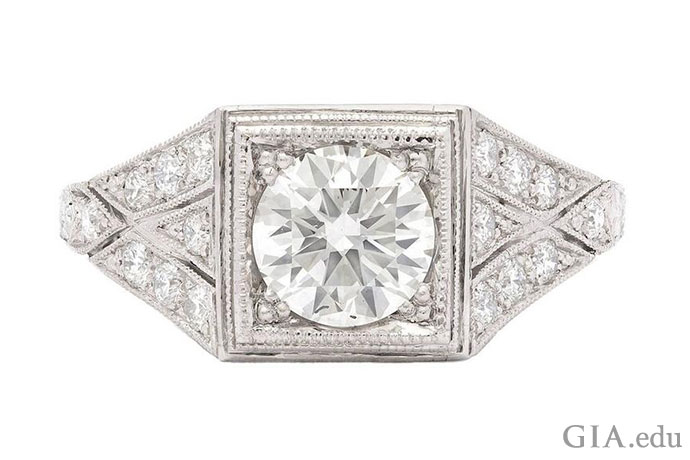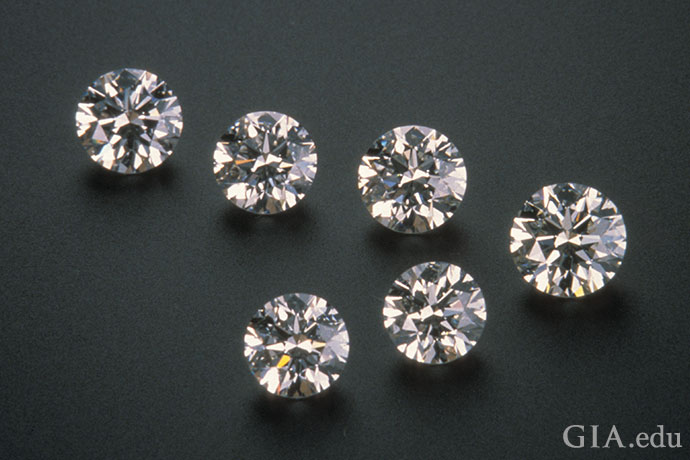Click here to get this article in PDF
The selection of engagement rings is near limitless and the prices for diamonds seem daunting. You may need to make some choices about where to put your money. Follow these tips for a ring you’ll be proud to give and that she’ll cherish forever.
The tips:
Let go of perfection
Understand how diamond quality is determined
Diamond Cut – don’t scrimp on cut
Diamond Color – can you tell the difference?
Diamond Clarity – don’t pay more for what you can’t see
Diamond Carat weight – go just under
Get a GIA Diamond Grading Report
Let go of perfection
More than anything else, a diamond engagement ring is a symbol of the enduring commitment and boundless love two people have for each other. It’s natural to want a ring that makes a grand statement and is absolutely perfect. However, when it comes to diamond engagement rings, searching for perfection leads to some serious sticker shock. The reality is the closer diamonds approach perfection, the rarer they are and rarity costs more.
If you’re willing to let go of perfection and make some small compromises, your engagement ring will still be perfect in her eyes – and you won’t break the bank before starting your new life together.
Understand how diamond quality is determined
Knowing where to put your money in a diamond engagement ring means understanding the GIA 4Cs: Color, Clarity, Cut and Carat Weight. These are the universal standard for describing the quality of a diamond and, like everything else, quality drives a diamond’s price.
Each “C” contributes to a diamond’s overall look in a different way. Decide which “Cs” are most important for you and you’ll know where to focus your spending. Each “C” is also assessed differently and offers a range of options, giving you even more opportunities to spend your dollars wisely.
As you read through the recommendations below, keep in mind that it’s extremely important to view diamonds in person. Diamonds with similar 4Cs grades can look very different and diamonds with dissimilar grades can look the same. Only by visually comparing diamonds can you determine the combination of qualities you find most appealing and how best to allocate your money.

The round brilliant cut is perennially popular, and this 2.28 carat (ct), G color, VS1 diamond is a stunning example of why it’s the diamond cut of choice. Courtesy: Pampillonia Estate and Fine Jewelry
Diamond Cut – don’t scrimp on cut
If you’re like most engagement ring shoppers, you want two things: a diamond with incredible sparkle and the biggest-looking diamond you can afford. So, if you read no further, take this advice: spend on a well-cut diamond.
A diamond’s cut quality refers to the skill with which the diamond was manufactured – its overall proportions, the symmetry of its facet arrangement and the quality of its polish. A well-cut diamond is bright, lively and delivers that eye-catching sparkle that telegraphs “diamond.” It’s well designed to ensure durability and well-proportioned so you’re not paying for unnecessary carat weight.

Diamond cut can make a significant difference in how a diamond looks. The 0.62 ct round brilliant on the left received a Poor cut grade, while the 0.73 ct round brilliant on the right received an Excellent cut grade. The 0.81 ct diamond in the middle has a Good cut grade. Photo: Kevin Schumacher/GIA
A diamond’s cut will affect how big the stone looks. It may have been cut to retain the most carat weight, but that weight can be poorly distributed. For example, extra weight can be hidden in or below the girdle – so you won’t see it. In fact, a poorly cut 1.20 ct diamond may appear to be the same size as a well-cut 1.00 ct diamond. A poorly cut diamond will look dull and lifeless, no matter its size.
If the diamond is well cut, many compromises in clarity, color and even carat weight can be forgiven.

A Very Good cut grade makes this 1.05 ct diamond dance with light. Courtesy: 1stdibs.com
Diamond Color – can you tell the difference?
Do you really need to spend big bucks on a diamond in the GIA Colorless range (D-to-F color)? Probably not. Once it’s set in a ring, it’s less likely that you’ll notice the difference between a diamond in the Colorless range and one that’s Near-colorless (G to J color). As you shop, compare mounted diamonds with different color grades on your hand. You might be surprised at the range of color you find acceptable. You might even prefer (as some do) a diamond that’s a little further down the GIA D-to-Z Color scale (J or K for example) that has some warmth.
Keep in mind, too, that a diamond’s color appearance will be strongly influenced by its surroundings. This includes natural and artificial light, the color of the clothing you’re wearing, and even the color of the metal in which the diamond is set. So, if you’re choosing a white metal, like platinum and want to emphasize the diamond’s absence of color, spend your money on a diamond with a color grade of H or better. At about J, K, or L, the contrast starts to become noticeable if the metal is very white (platinum). If you’re going with yellow gold, the slightly yellowish body color of a diamond with a lower color grade is less noticeable.

The more colorless a diamond is, the rarer it is. The rarer it is, the more expensive it will be.

The 2.50 ct center stone in this engagement ring looks colorless – but it has a color grade of G. Courtesy: EraGem.com
Diamond Clarity – don’t pay more for what you can’t see
Diamond clarity – or how free a diamond is from inclusions and blemishes – can be highly symbolic. For some diamond engagement ring shoppers, a flawless diamond represents a flawless love. But diamonds with a Flawless clarity grade are exceedingly rare; so rare that a jewelry professional may go an entire career without encountering one.
The diamonds you’re most likely to see will have some inclusions. But many will fall within the Very Very Slightly Included (VVS), Very Slightly Included (VS) and Slightly Included (SI) clarity grades that have inclusions only a trained diamond grader can see under 10× magnification. Within these grades there’s a lot of opportunity to save, since differences are impossible to detect with the naked eye. In fact, without magnification, an SI2 diamond may look the same as a more expensive VS1 diamond.

Three emerald cut diamonds set in a platinum ring. The colorlessness of the diamonds captivates the eye. Photo: Emily Lane/GIA
You may want to consider spending more on diamond clarity if you’re going with an emerald cut diamond. The long, rectangular facets that are characteristic of the emerald cut make inclusions more readily visible than among the many smaller facets of a brilliant cut diamond. However, if a diamond has many large clarity features, or if they are mirrored by the diamond’s many facets, they will be easy to see – no matter the shape or cutting style.

The center stone in this engagement ring is a 1.01 ct diamond with a clarity grade of VS1. It would be less expensive than a similar diamond with a higher clarity grade, and you still won’t see any inclusions with the naked eye. Courtesy: 1stdibs.com

The higher the clarity grade, the rarer the diamond. Diamonds with few or no clarity characteristics are rare and because rarity drives price, they will cost more.
If you’ve already narrowed your choice to a VVS or VS diamond, but can’t decide, this article explains the difference in their diamond clarity.
Diamond Carat weight – go just under
Carat weight is another factor with symbolic significance. If you’re looking for a large diamond to represent the magnitude of your love, be prepared to spend more. Large, high quality diamonds are rare, and therefore expensive. And because of their rarity, the difference in price isn’t linear but exponential.
Diamonds also become more expensive when they reach or just exceed certain weight thresholds, like 0.50 ct, 0.75 ct, 1.00 ct, etc. These numbers have symbolic meaning for some consumers, which translates to greater demand and higher prices. As you shop, be sure to compare these diamonds with those that have carat weights just below the thresholds. If all other 4Cs characteristics are equal, you won’t notice the difference in size and you’ll be able to realize some savings.
It merits repeating our recommendation about a diamond’s cut quality here: Don’t scrimp on cut. A well-cut diamond will look larger than a poorly cut one of the same or greater carat weight.

The diamonds in this photo range from 0.75 ct to 1.01 ct, but it’s challenging to see which ones are larger. Photo: Maha Tannous/GIA
Get a GIA Diamond Grading Report
When you go shopping for diamond engagement rings, make sure the diamond you’re considering comes with a GIA Diamond Grading Report. A report provides an unbiased evaluation of a diamond’s 4Cs and discloses whether the diamond has been treated to improve its color and/or clarity. Since GIA is a nonprofit institute with no vested interest in the sale, you can be confident that the information in the report is objective and accurate.

Shopping for an engagement ring? Ask for a GIA Diamond Grading Report.
Another big consideration in selecting the right diamond for an engagement ring is its overall style, which is largely defined by the shape of the diamond. There are many shapes to choose from, so read our blog for more tips on how to pick the perfect diamond shape for your beloved.
The post Engagement Ring Guide: Best Ways to Save Money on a Diamond appeared first on GIA 4Cs.
